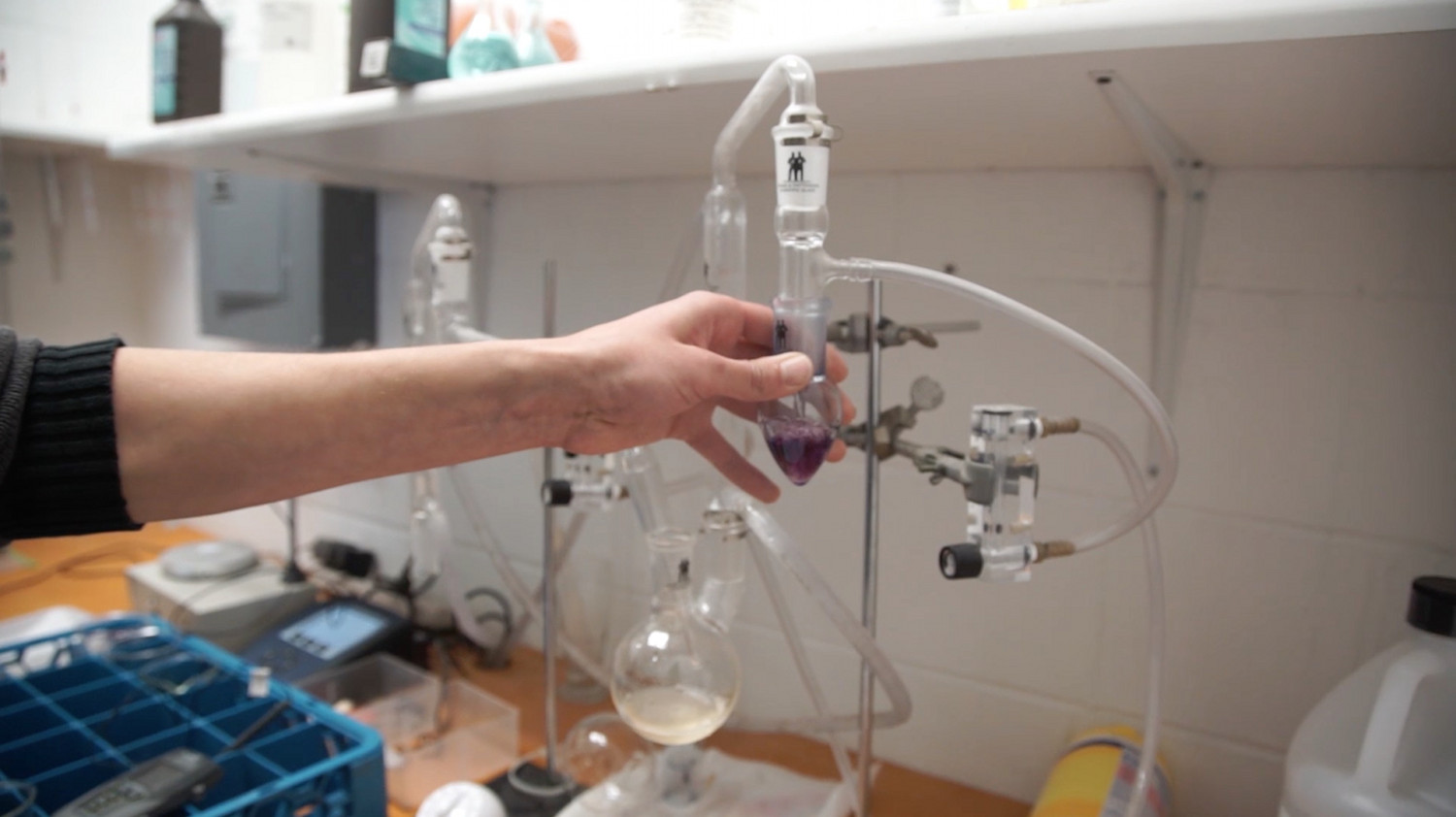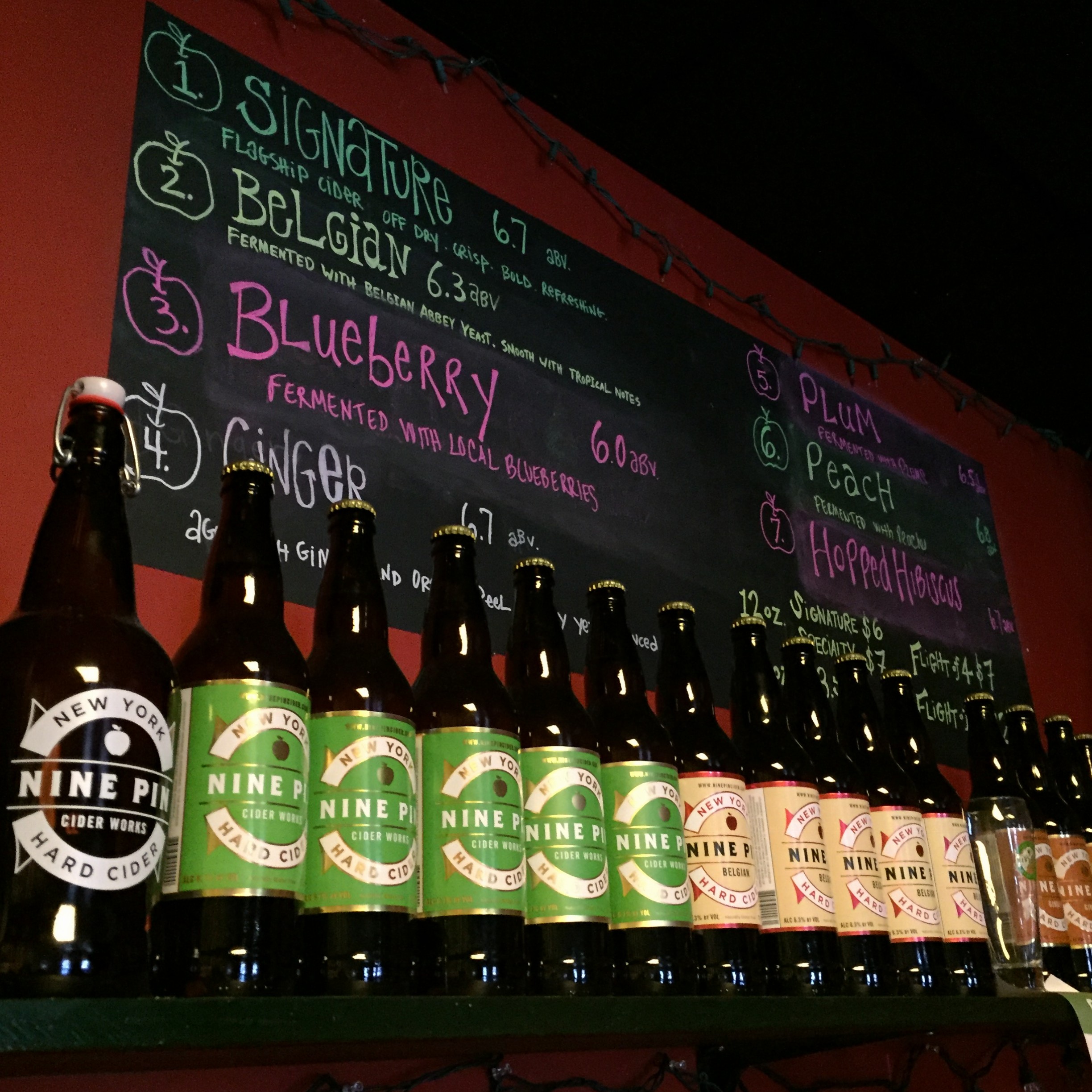Hard Cider, Easy Sipping
For one New York cidermaker, a variety of flavorful blends keeps the drink interesting.
The smell inside the warehouse of Nine Pin Ciderworks in Albany, New York, on a recent afternoon was unmistakable: alcohol, with a hint of sweetness.
The aroma wafted from three large plastic vats nearly filled to their brims with the juice of 21,000 pounds of apples recently picked from a nearby orchard. Gurgling loudly, the liquid belched carbon dioxide in a process crucial to turning pure apple juice boozy—fermentation. A gaseous haze hung over the vats at eye level.
Though this batch of cider totaled approximately 1,000 gallons, it was just a fraction of what Nine Pin normally produces, according to founder and head cidermaker Alejandro del Peral. Earlier, the 3-year-old cidery had been fermenting five times as much cider per week. “The amount of carbon dioxide that was produced by that much fermentation was actually toxic,” del Peral says. “We had to crack the doors open and let the air flow to keep us from passing out.” (They had scaled back for a few days in part because they were awaiting new equipment.)
Nine Pin is on track to produce 100,000 gallons of hard cider this year alone, says del Peral. The milestone is a long way from the small home batches he used to make—“mostly by accident”—from apples grown on his family’s land.
“I grew up in upstate New York, surrounded by apple trees. I’ve always had apples be part of my culture, to some extent,” says del Peral. “Every fall, we’d go picking. My parents have about 50 to 60 trees all planted from seed on their land, and we’ve always had an abundance of fruit around in the fall time.”
Random circumstance, however, led to his career in cidermaking. Del Peral had graduated from college with a degree in biology and was pursuing a master’s in hydrology a few years ago when he got to talking with a Vermont cidermaker while in line at a store. Intrigued, he soon signed on for an apprenticeship at the cidery, called Vermont’s Citizen Cider, eventually forgoing the master’s.
[How to craft the perfect pint.]
About two-and-a-half years later, del Peral returned to his roots in upstate New York to open up Nine Pin, named after the bowling game Rip Van Winkle played while drinking, before falling into his 100-year slumber. (“But we say: Drink responsibly,” del Peral insists.)
“New York has the second biggest apple crop in the entire country, and actually, we’re number one in the nation for apple variety—so we grow more types of apples than any other state,” says del Peral. “This is essentially a cidermaker’s dream place.”
When it comes to cidermaking, the process isn’t much different from winemaking, which also starts with fruit, says del Peral.
“The three basic elements in a cider are the sugar, acid, and tannin, so a great cider will have some balance between those three qualities,” del Peral says. “Our cider tends to be on the acid and sugar end of that spectrum.” Del Peral works with local orchards to learn about their apple crops each season, and that insight helps him create cider blends with different flavor profiles.
“We eat tons of apples, and we can bite into one, and it’s almost like we can envision what the fermented version of that could be,” he says.
Most cidermakers choose to include apple cultivars that tend to be bitter or dry and aren’t usually tasty to eat, according to del Peral. These so-called “cider apples” are often rich in tannins, which are naturally occurring chemical compounds that taste astringent and bitter, and that make the mouth pucker. Crabapples can lend these qualities, del Peral says.
[What gives bubbly its bubbles?]
Nine Pin’s signature blend contains about 15 to 20 different varieties of apples, which change depending on the season, but they’re usually offsprings of the McIntosh. Del Peral says the bright acidic flavor of the Mac gives a sharp and dry quality to the cider, finishing light and clean on the palate. “Makes it very dangerously easy to drink,” he says.
(Del Peral also makes special reserve cider from his family’s orchard. Whereas most apple orchardists graft their trees to maintain genetic consistency among their crop, his parents grow the apples from seed, a technique that produces genetically unique individuals, also known as pippins. They aren’t so good for snacking, but they’re suitable for sauces and baked goods in addition to cider.)
After they select their apples, Nine Pin presses the fruit into pure juice, then transports the liquid to the cidery. Next comes the fermentation. “All alcohol is made from yeast, which is a microbe which chews sugar and excretes carbon dioxide and alcohol,” says del Peral. Once the cidermakers mix yeast into the apple juice, they airlock the containers so that the CO2 can escape, but the alcohol won’t. (It also helps to keep the cider sanitary and safe from contamination.)
Nine Pin predominantly uses a commercial white wine yeast. ”It gives our cider a sort of a prosecco/moscato/sparkling wine-like quality,” says del Peral. But the company also produces a version made with a Belgian yeast, which is typically used for fermenting Belgian beers. “The aroma is sort of banana-esque and tropical fruity, and the mouthfeel is sort of creamier and more beer-like, ale-like,” he says. Apple skin contains some yeast as well, and Nine Pin allows some of their ciders to naturally ferment, but the results are much more unpredictable, so they usually only do this in small batches.
[Why is it easier to walk around without spilling a foamy beer vs. with a cup of regular coffee?]
In a process called co-fermentation, de Peral adds other ingredients to build cider complexity. “We’ve done it with blueberries, we’ve done it with raspberries, we’ve done it with aloe vera, we’ve done with hawthorns, cardamom, walnuts—we’ve gotten crazy with the co-fermentations,” del Peral says. Because the yeast consumes the sugar within the added ingredient, it infuses the alcohol with additional natural flavor. In the case of Nine Pin’s blueberry cider, for instance, “it results in a really well-integrated blueberry note to the final product,” del Peral says.
Nine Pin lets their cider ferment for about seven to 10 days, after which they transfer the liquid to new containers to age anywhere from three months to a year. During this time, the cidermakers monitor the cider by testing its acidity, or perceived sourness.

“When you bring in the sweet juice, fresh-pressed from the orchard, a lot of times, there’s so much sugar in there, it’s hard to judge how sour the fermented version of it will be,” del Peral says. Nine Pin checks this sourness by doing an acid-base titration, in which they take a known base solution and add cider to it, bit by bit, until the mixture reaches a neutral pH. Based on how much acid they needed to neutralize the base, the cidermakers can tell what the perceived sourness of the final cider is going to be. They can then determine whether they’ll eventually need to add sugars at the end, a process known as backsweetening.
Nine Pin also mixes sulfur dioxide into the aging product.
“Sulfur dioxide has been used in winemaking since the Greeks did it back in the day. They’d pull it out of volcanic areas and add it to their wines,” del Peral says. “Oxygen is always the enemy in alcohol production, and can really tweak flavor and aroma in sometimes very negative ways.” Sulfur dioxide binds the oxygen, preserving the flavor and aroma of the cider as it ages, as well as protecting the liquid from contamination. “As cider sits and ages, it’s vulnerable to infection from a wide variety of microbes that are also presented in the juice before fermentation. The SO2 basically helps prevent those microbes from establishing themselves and allows the cider to age and mature without essentially turning to vinegar and generating other off-flavors that can be created by those other spoilage organisms,” explains del Peral.
[Is it ok to drink alcohol when you have a cold?]
The aging stage is another chance for Nine Pin to experiment with flavor infusions. They’ve added dried ginger to the batches, or put the cider into bourbon barrels instead of the regular plastic containers to give the liquid a strong oak and bourbon quality. Because cider is so light-bodied, “you can easily pick up the small, subtle flavors from other ingredients,” says del Peral.
Finally, the cider is packaged in cans and bottles, and shipped off to retailers across the state, and recently, in Massachusetts.
Traditional cidermaking has a long history in Europe and the U.S., but it’s only in recent years that the industry has seen a big surge in business. “The category has grown by enormous leaps and bounds, in terms of its popularity and in terms of the cidermakers who are coming onto the market,” says Jenn Smith, lead producer of Cider Week NY, an annual cider event in New York City and the Hudson Valley and now in the Finger Lakes. “If you look back even 10 years ago—even six years ago—there were far fewer ciders on the market. The idea of cider as a category was really undeveloped in the world of craft beer and fine wine.”

Del Peral attributes the growth to both the gluten-free and farm-to-table movements, as well as the growing interest in craft beer brewing. “The craft beer movement has trained the consumer to be experimental in what they drink, so people are open to trying different things,” says del Peral.
But because cider still remains a niche industry in the U.S.—Smith estimates that there are around 60 licensed cidermakers in all of New York, a leading craft producer—del Peral sees his job as an opportunity to be creative and innovative.
“There’s no real expectation to what cider has to be. We make it like a wine, but we can also experiment in the same way that craft brewing industry is experimenting, and no one really tells us not to,” del Peral says. “It’s like the Wild West, and we’ve got everything that’s cool about winemaking, and we’ve got the freedom that’s in the culture of craft beer making. We get the best of both worlds.”
[Even voles know that love and alcohol are a complex combination.]
Chau Tu is an associate editor at Slate Plus. She was formerly Science Friday’s story producer/reporter.